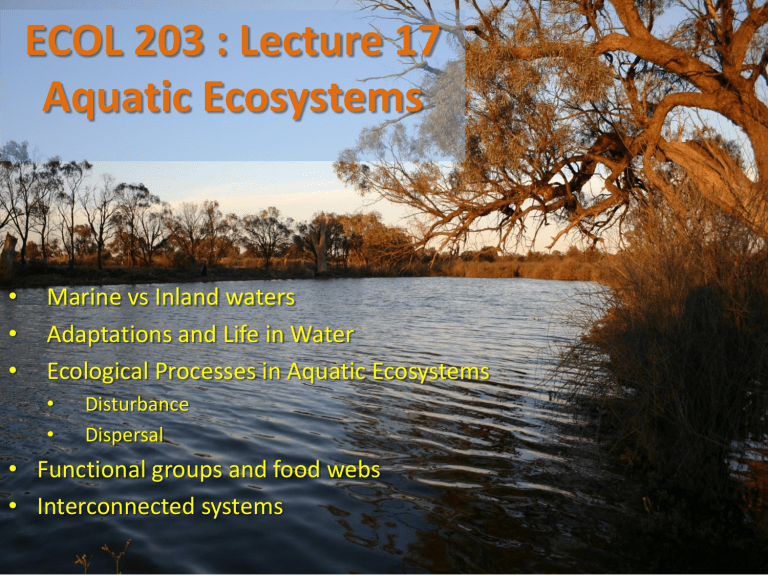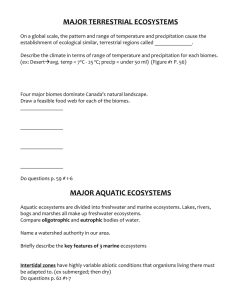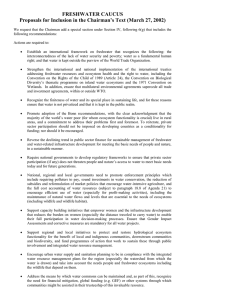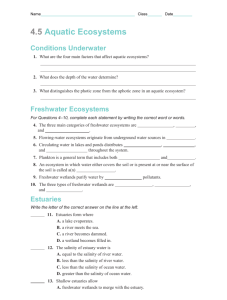
ECOL 203 : Lecture 17 Aquatic Ecosystems • • • Marine vs Inland waters Adaptations and Life in Water Ecological Processes in Aquatic Ecosystems • • Disturbance Dispersal • Functional groups and food webs • Interconnected systems Water Resources Aquatic systems: The salty divide • Marine vs Inland waters • Transitional ecosystems – estuaries & saltmarshes • More ecological overlap – Turbulent rivers and rocky shores – Large lakes and the open ocean – Physiological similarities between inland salt lakes and coastal lagoons Key defining characteristics Marine and Freshwater Systems Spatial Extent-depth The area of inundation and the depth of the water. Volume Extent and depth influence the amount of water at any given time. Temporal Timing When water is present. Frequency How often filling and drying occur. Duration Period of inundation. Variability The above features change at a range of time scales. Key defining characteristics Marine and Freshwater Systems Benthic Zone/ photic Benthic Zone / aphotic Physical properties of water • Physical – Turbulence/wave action/flow – Light and Temperature • Chemical – – – – Salinity (mg/L)/Conductivity (µS/cm) Acidity/alkalinity (pH) Dissolved organic matter Pollution and contaminants A dash of salt ……… Seawater vs Fresh water • Marine systems: Approximately 85% of the dissolved materials in seawater are sodium and chlorine. • Freshwater systems: dominated by Sodium, Calcium, Potassium and/or Magnesium salts. • Seawater has an average salinity of 35 g/L Image coutesy of http://www.mangrovewatch.org.au Majewsky - Sea_salt-e_hg.svg. Licensed under CC BY-SA 2.5 via Wikimedia Commons – uploaded Feb 19, 2015 Estuarine Ecosystems River Freshwater Pycnocline – density difference due to salinity Sea ‘Salt wedge’ Upwelling nutrients Tidal surges import sea water • Ecotone – transition zone between ecosystems • Position will vary with flow conditions over time Salinity in inland waters • This salt primarily comes from weathering, historic deposits of marine sediments • Can exceed that of seawater (35 g/L) • Over 360 g/L recorded (maximum solubility of sodium chloride) Primary salinization (natural process) • Naturally saline standing and running waters are common across Australia Secondary salinization (Anthropogenic) – land clearing and irrigation – mining and other industries, effluent from sewage treatment plants Osmoconformersinternal = osmotic conc of the external environment. Osmoregulatorsinternal osmotic concentration regulation maintain levels that may be different from the external environment Matters of light and depth.. • Red (long wavelengths) are absorbed first – vertical distribution of plants • Absorbed light photon releases energy as heat • Temperature profiles with depth differ from those of light because of stratification Boulton et al. (2014) Australian Freshwater Ecology.Fig 2.4. No flow: Thermal stratification and oxygen Vertical temperature profile with depth under conditions of direct stratification in a standing water. From Boulton et al, 2015. Ch2. Holding on … Physical disturbance • Tidal cycles cause abiotic factors to vary over short vertical range of the intertidal zone • Distinct zones or bands of species www.poulsbomsc.org/coastaljourney/intertidal.htm Living in the fast lane Morphological Adaptation: • • • • • Flattened form Stream-lined and fusiform Permanent attachment Tiny size Sucker-like modifications Images: Boulton et al. (2014) Australian Freshwater Ecology. Ch 7. Living in the thefast fastlane lane Living in Behavioural • Seeking refuge below or behind particles • Postural changes and facing upstream • Powerful bursts of swimming Yabbie in hole: Doyle. http://www.flickr.com/photos Blackfly larvae: Waterbug Book, Courtesy of J.Gooderham Dispersal in aquatic systems • Benthic species: primary dispersal phase (spore, egg, or larva). • Mobile species: juveniles and adults may disperse. • Consequences for processes of colonization, gene flow. Active or Passive Dispersal (freshwater), • Active: flight in adult freshwater insects • Passive dispersal: transport by animal vectors, wind, desiccation-resistant stage in the life cycle. Migrations WHY MIGRATE: Dispersal Habitat Food • Trigger to migrate – Increased flow, – Changed temperature and salinity, – Day/night length. • Reproductive migrations: – Diadromous (migrate to salt water for breeding) • Catadromous (downward running): fishes hatch or are born in marine habitats, but migrate to freshwater areas where they spend the majority of their lives growing and maturing. As adults they return to the sea to spawn (e.g., Long-finned eel). • Anandromous (upward running) hatching and a juvenile period occur in freshwater. This is followed by migration to and maturation in the ocean (e.g., salmon). – Potamodromous (migrate within freshwaters, e.g., Murray Cod) Long-distance marine migrations Connecting foraging and reproductive sites • • • • Fish - Atlantic bluefin tuna Sea turtles Northern elephant seal Cetaceans Blue fin tuna migration Balazs & Ellis. http://www.turtles.org/ffs/migrate/ffsmigrt.htm Interconnected Ecosystems Ecological Groupings of Aquatic Organisms Functional Groups producers, grazers, consumers, detritivores • Eg. Pelagic foodwebs – Phytoplankton (algae) grazers predators BUT – Bacteria/ cyanobacteria/ microprotozoans/algae all in the production network – Phytophagous protists (grazers and predators) Food webs • Consumers are heterotrophs • Grazer-based foodwebs • Detrital based foodwebs Boulton et al. (2014) Australian Freshwater Ecology. Ch 4. Interconnected Ecosystems Autochthonous • Organic matter derived from photosynthetic production within the water column – Attached algae/cyanobacteria – Planktonic algae – Macrophytes Allochthonous • Organic matter derived from photosynthetic production of terrestrial origin – Mangroves – Riparian vegetation – Catchment vegetation Connectivity in Rivers • LONGITUDINAL: This is the way that water moves downstream. – nutrients, sediments, – animals • LATERAL: links with the riparian vegetation, river banks and the floodplain. • VERTICAL: This is how the river links with the groundwater system Boulton et al. (2014) Australian Freshwater Ecology. Fig1.7 Groundwater Connectivity Water occurring below ground in saturated and unsaturated sediments, rock fissures, or solute cavities Fractured rock (confined) aquifer Cave / karst Alluvial (unconfined) aquifer Impermeable layer Groundwater Ecosystems • Aquifers not inert bodies of water, but contain active biological communities. • No primary production - detritus-based food webs • bacteria – base of food web, Stygofauna (groundwater animals) denitrification, bioremediation, process OM • invertebrates – mediate bacterial activity, dominated by crustacea • fish – 2 species in Australia Adaptations to Groundwater Life • Life cycles – low fecundity, long-lived • Low species richness/ abundance (compared to surface) • Many short-range endemics (restricted to single aquifers) • Therefore, at risk from disturbance Interconnected Ecosystems Summary Zones have common features & processes across marine & freshwater systems Living in water – Salt : adaptations, estuaries a special ecotone – Light – Stratification – thermal, oxygen Ecological Processes in aquatic communities – Disturbance • tidal, flowing water – morphological and behavioural adaptations – Dispersal – active and passive methods & migration Functional groups and food webs – Producers, grazers, consumers - key function of detrital based food webs in aquatic systems Interconnected systems: – Groundwater – Allochthonous and Autochthonous organic matter sources





